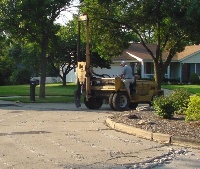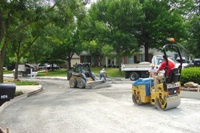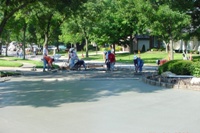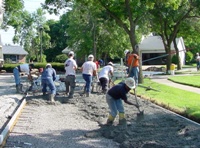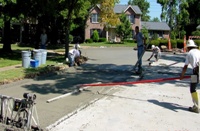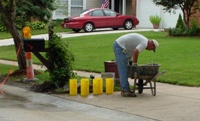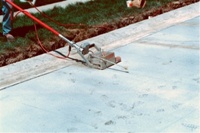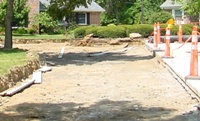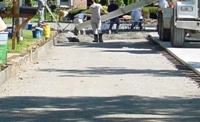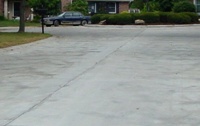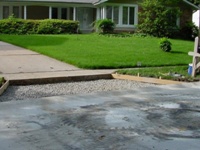What to Expect During Concrete Slab Replacement
|
In order to maintain the City's streets at acceptable levels, many types of maintenance are performed each year. When other maintenance methods have extended the life of the pavement as far as possible, complete replacement of the pavement is the final maintenance option. Streets are selected for pavement replacement based on pavement ratings performed by City staff at least once every three years. The streets where pavement replacement will be completed are generally selected in the late fall and early winter. Pavement replacement is not normally undertaken until a relatively large area (on the order of 300 plus feet in length) of pavement is in need of replacement. Once the general areas to be repaired are determined, the specific beginning and end of each repair area is determined. While the City prefers to repair all pavement in an area while we are working nearby, budget constraints and the condition of other pavements in the City often require that marginal pavements be left in service. Construction plans are then prepared and the project is publicly bid. The residents adjacent to the construction area and the trustees of the affected subdivisions are notified by mail once the bids are opened and a contractor selected. Further communications between the City, the contractor and the residents are conducted via "step stakes". These are small plastic stakes similar to those often used by lawn service companies. The City will place the stakes next to the mailbox and place notices there. We find that this method of leaving notices is both timely and effective. What to expect once construction starts. Prior to the contractor starting in an area, the City will trim tree limbs in the work area, mark the limits of the pavement to be removed, and mark driveway aprons to be replaced. At about the same time, the contractor will contact the local utilities and have the underground utilities marked. One or two weeks before the contractor expects to start working in an area, the City will deliver notice of an onsite meeting to the affected residents. The purpose of this meeting is to answer any questions that the residents may have. "No Parking" signs will also be placed in the vicinity of the work area at this time. The work will be phased to minimize the inconvenience to the residents, yet allow the work to be completed as quickly as possible. Generally, one half of the width of the street is constructed first, followed by the second half of the street. Depending on the length of the street, the entire length may be done at once, or the length may be divided into several sections, each constructed in turn. The first construction activity is to break up the existing pavement so it can be excavated and safely hauled from the area. Slightly more than one-half the width of the street is removed in the first phase. This allows concrete forms to be installed along the new center line of the street. Figures 1 and 2 show the breaking and excavation process. It generally takes about one day to break and excavate a street section. Residents who will not be able to access their driveway should receive a notice on their step stake from the contractor two days before the start of this work. This stage of construction is noisy and may cause the ground to shake. In addition, it is not uncommon for a mailbox to be damaged or a low hanging tree limb to be broken. Damaged mailboxes and sprinkler systems will be repaired once the heavy construction is complete and any damaged tree limbs will be trimmed following completion of the work. Please note that sprinkler systems will not be repaired unless a hold harmless agreement is on file with the City. Once the existing pavement has been removed, concrete forms are set, geotextile fabric is spread, and crushed stone is dumped, Figure 3. The rock is then carefully spread and graded to allow for the proper thickness of concrete, Figure 4. Prior to placing concrete, the rock thickness and compaction is checked by the City's inspector. This process may take two or three days, depending on the length of street being replaced and the required grade changes.
Once the crushed stone has been tested, the contractor will schedule the concrete placement. Placing the concrete is labor intensive, Figures 5, 6 and 7. The City's inspector performs several quality control checks as the concrete is being delivered to the project and as it is being placed by the contractor, Figure 8. Depending on the size of the crew and the amount of concrete to be placed, between one and three days are generally needed to complete concrete placement.
The concrete surface is finished with a 10-foot straight edge for smoothness and is textured to provide traction. Then a curing compound is sprayed on the surface, Figure 9. This white compound helps the concrete gain strength and durability. The bright white color will fade to the natural color of the concrete with time. Once the concrete starts to set, joints are cut in the surface to allow the concrete to crack in a controlled manner. These joints are usually cut the same day the concrete is placed, Figure 10. The timing of cutting the joints is crucial and usually requires work past normal working hours and into the evening. We are sorry for any inconvenience that this may cause. However, if the joints are not cut in time, the concrete will crack in a random pattern. Random cracks require that the entire pavement replacement process be started again.
Time is then required for the concrete to gain adequate strength to support traffic loads. The rate at which concrete gains strength is dependent on many factors, one of which is the weather. Generally after three to five days, the street is opened to local traffic. During this period, the forms are removed and the excavation along the side of the road is backfilled, and driveway aprons are replaced, if needed. Seed and straw are usually not placed until the second half of the street is complete. Approximately one week after the first half of the street is placed; the second half is started following the same process. Figures 11 and 12 show the second half of a street under construction, while Figure 13 shows the completed street. The black marks shown in Figure 13 are from the "skid steer" used to backfill the edge of the street and spread the rock. While these marks are harsh in contrast to the white surface of the concrete, they will fade with time. The alternative to avoid the tire marks is to backfill the street by hand. Hand work on that scale is neither time efficient nor cost effective.
As noted previously, some drive approaches must be replaced as part of the street project. Approaches are not replaced because they are unattractive or in bad shape; they are only replaced if their condition or elevation does not allow the new street to be constructed properly. Drive approaches serve private property and the City is not responsible for their maintenance. The approach is simply the part of the private driveway that has been constructed on City right-of-way and as such is the responsibility of the property owner. When approaches are replaced, the forms and concrete are placed after that half of the street has been completed, Figure 14. If the approach is being replaced with concrete, then about three days will be required after the concrete is placed before the approach can be driven on. The contractor will remove the barricades when it is safe to drive on the new concrete. Please remember that the actual progress of the work will depend on weather conditions and the contractor's work methods. The time frames stated in this document are representative of average conditions. They also assume that unusual problems are not encountered. While the City specifies the amount of time allowed for completion of all work under the contract and closely monitors progress throughout construction; the contractor determines his work schedule and staffing levels and the City has limited ability to impact or influence them.
The equipment and construction methods shown in this document are from past projects completed within the City. The actual equipment and methods are likely to vary as not all contractors are equipped the same or approach projects in the same way. |

